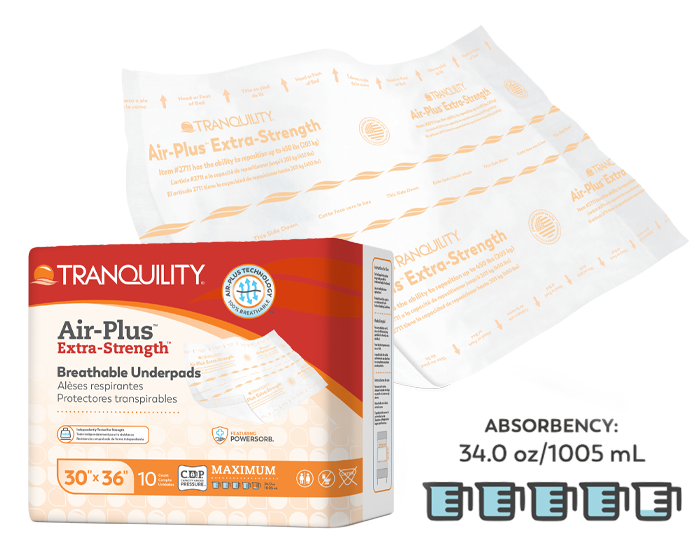When it comes to managing incontinence, selecting the right bed pad is essential for ensuring comfort, protection and peace of mind. A bed pad, also known as an underpad, provides an effective barrier to protect your mattress from urinary leakage, while keeping you or your loved ones comfortable throughout the night. With so many options available on the market, knowing which features to prioritize can help you make the best choice.
This guide will walk you through everything you need to know about choosing the right bed pads for incontinence, including key factors like absorbency level, material and additional features to fit your specific needs.
The Importance of Bed Pads for Managing Incontinence
Bed pads are an essential product for anyone dealing with incontinence. They not only protect bedding and furniture but also provide a clean and hygienic environment for sleeping and resting. Whether you’re looking for reusable bed pads or disposable ones, the ultimate goal is the same — providing comfort and protection as well as easy cleanup.
The right bed pad can:
- Protect your mattress and furniture from damage.
- Minimize skin irritation and discomfort by wicking away moisture.
- Reduce nighttime disturbances, so you can experience quality sleep.
- Simplify daily clean-up routines.
Key Factors to Consider When Choosing Bed Pads
Absorbency Level
Absorbency is one of the most critical factors when purchasing incontinence bed pads. Some bed pads are designed for light leakage, while others can handle heavy voids or overnight leakage.
Look for options with superabsorbent cores, which trap moisture effectively and keep it away from the skin. For example, Tranquility® Air-Plus® Extra-Strength Breathable Underpads made with absorbent material hold and lock in up to 34 ounces of liquid, ensuring maximum protection.

Size and Shape
Bed pads come in various sizes and shapes. For full bed coverage, consider a larger bed pad that can extend across the entire mattress, such as 30” x 36” pads. For smaller surfaces, compact options may be sufficient. Be sure to select a bed pad that fits well and provides adequate protection for your specific situation, whether it’s for a bed, chair or wheelchair.
Material and Breathability
Materials play a big role in both comfort and quality. Opt for a bed pad with a soft quilted top layer that is gentle on the skin and made with breathable materials. This allows air to circulate, reducing the chance of irritation, particularly for individuals with sensitive skin.
Washable bed pads are usually made from durable fabrics that can withstand multiple washes, while disposable pads offer the convenience of easy cleanup.
Odor Control
Many brands design bed pads with odor-neutralizing technologies to trap smells along with moisture. If odor control is a major concern, look for products specifically designed to minimize odors, such as those with moisture-wicking features or high-absorbency layers.
Additional Features to Look For in a Bed Pad
Some bed pads come with extra features that can enhance your experience:
Waterproof Backing
For reliable protection, look for bed pads with a waterproof backing. This feature ensures that no moisture leaks through the pad and onto your mattress or furniture, keeping surfaces dry and free of damage. Waterproof layers are especially important if you’re looking for overnight protection or if you are managing heavy leaks.
Secure Fit
Some bed pads come with adhesive strips or fasteners to hold them securely in place. This helps prevent the underpad from shifting during use, providing secure coverage and preventing unnecessary messes. Pads without these features may shift, which can make them less effective.
Hypoallergenic Options
If you or your loved one has sensitive skin or allergies, look for hypoallergenic bed pads. These products are made without irritating chemicals and dyes, so they’re gentle and safe for extended use.
Washable vs. Disposable Bed Pads
Like other incontinence products, you can choose between washable bed pads and disposable versions. Here are some key benefits of each to help you decide what will work best for you.
Washable bed pads
Washable bed pads are reusable and environmentally friendly. They can be more expensive initially, but cost-efficient over time. They’re ideal for people who prefer sustainable options or want to cut costs.
Disposable bed pads
Disposable pads are convenient and easy to dispose of, making them a preferable option for busy caretakers or during travel.
Making the Right Decision
Selecting the best bed pad is an empowering step toward managing your incontinence with confidence and ease. By focusing on the factors mentioned above, you can find the perfect bed pad to protect your bedding, simplify cleanup and improve your overall quality of life.
For more helpful insights on finding the right bed pad for your incontinence needs, check out this article that provides more tips for finding the right bed pad.
For more information or questions about this article, please call 1-419-352-1551 or email CustomerService@pbenet.com.